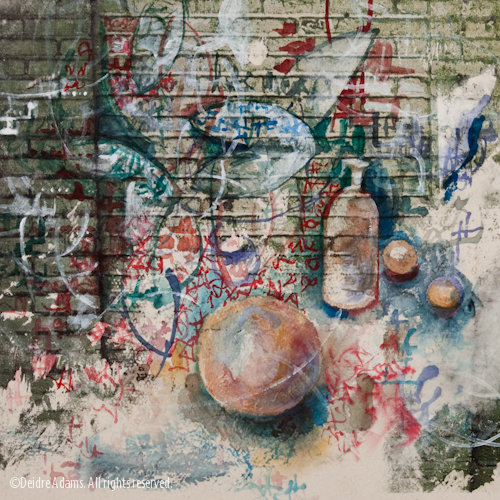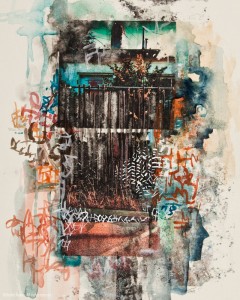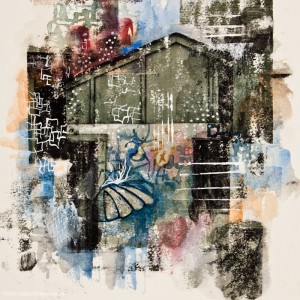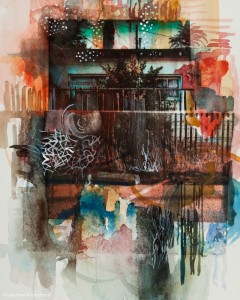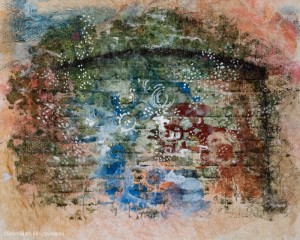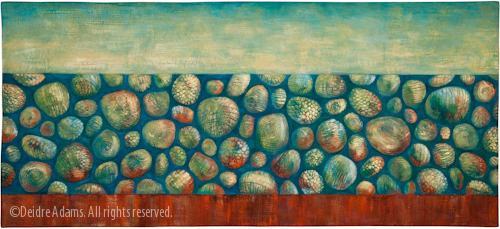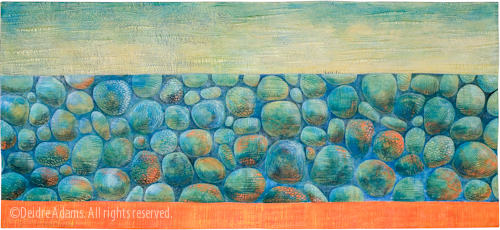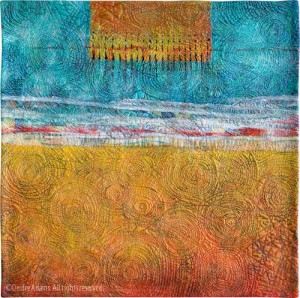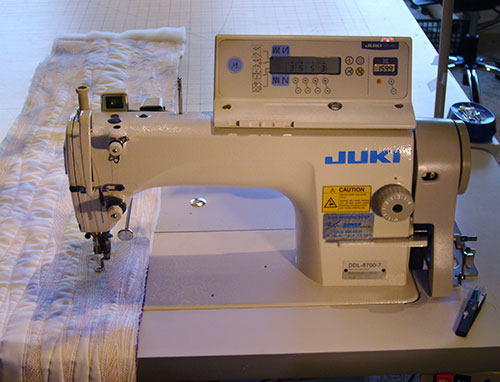
Today I took the dust cover off of my beloved Juki DDL-8700-7 for the first time in months. I haven’t done any sewing since the beginning of the semester back in January. I’ve been very busy with my studio classes in printmaking, watermedia, and painting, as well as a class for my general studies science requirement called Ecology for Non-Majors and a multi-cultural requirement class called Art & Cultural Heritage. In addition to this, I have several freelance design projects going on, but I really find it boring when people go on ad nauseum about how busy they are, so enough said about that.
The studio work has good and bad points. While it does push me to think in new directions and takes me out of my established patterns, it also distracts me from pursuing my own body of work. My mind is full of lots of ideas and concepts for things I want to do, none of them having anything to do with fabric. I’ve been really enjoying the painting and mixed media work I’ve been doing this semester, both in watermedia on paper and acrylic on canvas. So much so that I’ve wondered if I even want to go back to doing my textile work in the near term.
Well, something did come up that kind of forced the issue. Thanks to the very hard work of Kate and Judy at Translations Gallery, I have a commission! That’s the good news. Bad news: it’s due May 18, just a few short weeks away. The client wants another version of a piece I’ve already done, sold to EnCana Corp. last year, but now with a slight variation of the color on the bottom strip.

Iterations #1: Aquamarine, 30 x 66 inches, © 2006 Deidre Adams
So last night I got started on the prep work of cutting and ironing the fabric and basting the pieces together with the batting. Then this morning, I got down to the serious business of the quilting. Well, just a few minutes into it and I quickly remembered why I love the textile medium. The magic is still there. This medium has a tactile hands-on aspect that simply is not available in the other media I’ve been working in. I love the feeling of the fabric in my hands, the meditative back-and-forth rhythm of the stitching process, and the zone I get into when I’m working this way. The finished product has a dimension and depth that a painting lacks.
When I made this piece the first time, I was working with my Bernina Artista 180. At that time, I thought it was a pretty good machine, and it is, but I was feeling dissatisfied with it because of the restrictions of the small area of the center open space (I’m too lazy to look up the technical term for this, so if anyone knows offhand, please chime in) and also because I felt like it was too slow — I pretty much had it floored all the time and it still felt like it took forever to quilt something. It has a lot of fancy stitches and an embroidery attachment, which I have used exactly once. While it is a very fancy machine and cost a lot of money, it just was not built to do what I need it to do, which is take a huge pounding putting a gazillion stitches into some rather large pieces.
My first try at remedying the situation was the Grand Quilter from Pfaff. The store I went to is used to selling this machine with a frame and setup stuff that basically turns it into a long-arm quilting machine. I didn’t want all that stuff, I only wanted the machine, so they really weren’t equipped to deal with my questions. I bought it anyway and took the thing home, but within 30 minutes of using it, I knew I wasn’t going to be happy with it. It was very loud and clunky and I returned it the next day.
The next step was to go to industrial. In Denver, that means Ralph’s Industrial Sewing Machine Company. This was a whole new realm for me. Turns out there is an amazing variety of industrial machines out there, including machines built to quilt mattresses, so they also had a hard time understanding what I needed. We went through quilt a few different models, with me testing each one using a sample quilt I had brought with me. I finally settled on this Juki machine because it sews 5,500 stitches per minute, has a large opening and an automatic thread cutter, and it counts down how much thread is left on the bobbin. Cool! It’s heavy and solid and sits in its own table. It is also amazingly smooth and quiet, and it has its own oil pan so I don’t have to oil it. Yay! Another bonus: everything in the industrial machine world, like thread and needles, is SO much cheaper than in the commercial home sewing world.
It was a bit traumatic getting the machine to work in the beginning. Because it was designed for straight-stitch garment sewing and I was doing free-motion quilting, which means yanking the piece in all different directions, I had a lot of thread breakage issues at first. Luckily, the technicians at Ralph’s are very professional, and the guy who came out on three different occasions finally hit on the right combination of presser foot, throat plate, bobbin case, needle, and customized hook assembly so that now it’s smooth sailing, full steam ahead. I can even use rayon thread with very little problem.
I’ve decide that this time, I’m going to work this piece in three separate sections and put them together after the quilting process, because it’s very difficult to keep the lines between the sections straight when each has different amounts of quilting from the others. This time, I finished the quilting on the first section of the piece in just a couple of hours — a huge improvement on the last time.

